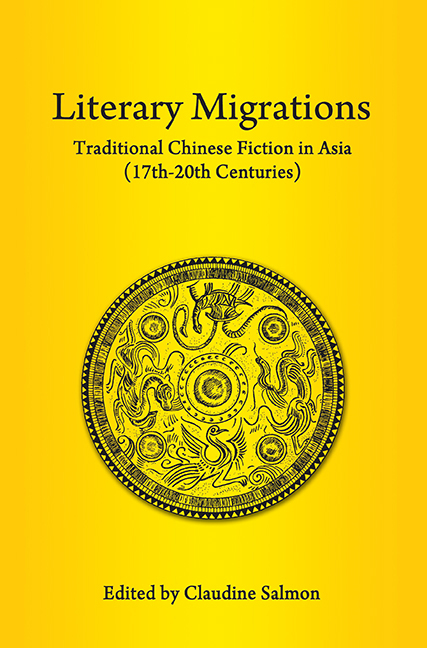Book contents
- Frontmatter
- Contents
- FOREWORD
- Dr Salmon as I Know her
- Preface to Reprint Edition
- Acknowledgements
- INTRODUCTION
- PART I KOREA AND JAPAN
- PART II MAINLAND NORTHEAST ASIA
- PART III MAINLAND SOUTHEAST ASIA
- PART IV INSULAR SOUTHEAST ASIA
- 10 A Note on Javanese Works Derived from Chinese Fiction
- 11 Malay Translations of Chinese Fiction in Indonesia
- 12 Writings in Romanized Malay by the Chinese of Malaya — A Preliminary Inquiry
- 13 Lie Sie Bin Yoe Tee Hoe — Six Malay/Indonesian Translations of a Chinese Tale
- 14 Liang Shanbo yu Zhu Yingtai — A Chinese Folk Romance in Java and Bali
- 15 Translations of Chinese Fiction into Makassarese
- 16 Sam Pek Eng Tay — A Chinese Love Story in Madurese
- 17 Post-war Kung Fu Novels in Indonesia — A Preliminary Survey
- Bibliography
- Author, story-teller and translator index
- Title index
- List of Plates
- Contributors
- Plate section
12 - Writings in Romanized Malay by the Chinese of Malaya — A Preliminary Inquiry
from PART IV - INSULAR SOUTHEAST ASIA
Published online by Cambridge University Press: 21 October 2015
- Frontmatter
- Contents
- FOREWORD
- Dr Salmon as I Know her
- Preface to Reprint Edition
- Acknowledgements
- INTRODUCTION
- PART I KOREA AND JAPAN
- PART II MAINLAND NORTHEAST ASIA
- PART III MAINLAND SOUTHEAST ASIA
- PART IV INSULAR SOUTHEAST ASIA
- 10 A Note on Javanese Works Derived from Chinese Fiction
- 11 Malay Translations of Chinese Fiction in Indonesia
- 12 Writings in Romanized Malay by the Chinese of Malaya — A Preliminary Inquiry
- 13 Lie Sie Bin Yoe Tee Hoe — Six Malay/Indonesian Translations of a Chinese Tale
- 14 Liang Shanbo yu Zhu Yingtai — A Chinese Folk Romance in Java and Bali
- 15 Translations of Chinese Fiction into Makassarese
- 16 Sam Pek Eng Tay — A Chinese Love Story in Madurese
- 17 Post-war Kung Fu Novels in Indonesia — A Preliminary Survey
- Bibliography
- Author, story-teller and translator index
- Title index
- List of Plates
- Contributors
- Plate section
Summary
Over the centuries some of the Chinese emigrants who left home hoping to return to their native land one day, for various reasons settled for good in the countries of the “South Seas” and married local women. Their descendants gradually formed mixed communities which sometimes tended to live a self-contained life, cut off from the local population because they were grouped in certain districts in the towns, and from the Chinese who arrived after them and whose economic situation was incomparably more wretched than that of the merchant communities. The members of these communities, known as Baba and sometimes also as Peranakan all over the Malay Peninsula, were from Malacca. Throughout the nineteenth century they migrated to other centres in Malaya, in particular to Penang and Singapore, where they became the trading elite, until they were supplanted at the turn of the century by merchants from China. One characteristic of this society of Chinese descent was that it often gave up using written, and even spoken, Chinese and turned to Malay instead.
Many studies have been made of the historical, sociological and linguistic aspects of the communities, but apparently until the late 1970s nobody had raised the question of how, and to what extent these communities felt the need to create a literature in Malay. In 1969 Png Pohseng, in an article entitled “The Straits Chinese in Singapore: A Case of Local Identity and Socio-cultural Accomodation” avoided the question, when he wrote:
Baba Malay was little more than a spoken language. When it came to reading and writing the Straits Chinese turned to English. A few did try their hand at writing romanized Baba Malay, including the translation of Chinese historical romances such as the San-kuo and Christian hymns for use in Protestant churches, but no substantial literature emerged in that medium.
The translation of the Sanguo or “Romance of the Three Kingdoms” mentioned here was the work of Chan Kim Boon, a Chinese from Penang; it was in thirty volumes and appeared between 1892 and 1896. In our view, the scale of this translation, which was 4,622 pages long, suggests that a reading public existed and that the question of “Sino-Malay” literature, consisting either of translations or original works, cannot be brushed aside so quickly.
- Type
- Chapter
- Information
- Literary MigrationsTraditional Chinese Fiction in Asia (17th–20th Centuries), pp. 277 - 314Publisher: ISEAS–Yusof Ishak InstitutePrint publication year: 2013

